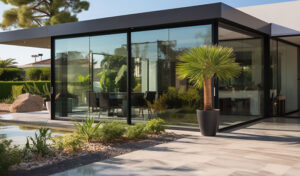Glass repair can seem like magic to those outside the industry.
Glass is an anomaly — tough enough to protect us from raging winter storms yet fragile enough that it shatters relatively easily. It’s transparent, but it’s made from the same kind of sand that sticks between your toes at the beach.
Glass acts like a solid, but it’s actually a liquid. It’s all around us, from our windows to the rearview mirrors in our car. It’s one of the oldest, most useful materials created by man, but few people know much about it.
Technically, glass is liquid sand that’s created when regular sand is heated to the point of melting. Sand is largely made up of silicon dioxide, and when it gets really hot, it becomes liquid. But the heat levels must reach at least 3,090 degrees Fahrenheit, which is why you don’t see beaches turning to liquid on even the hottest days.
Once melted, sand cools down and transforms into glass, never to return to its formerly gritty state. When it’s cooled, it acts like a solid, but it will always be an amorphous solid.
The Metamorphosis
Amorphous solid sand is half liquid, half solid, and boasts a crystalline quality with the molecular structure of liquid. As you can see, it’s quite a unique product!
Glass became popular due to its versatility. Its transparency combined with its low cost made it a favorite for manufacturers. It’s easy to mold when in molten form, and resists heat well in the amorphous solid state. Plus, it’s chemically inert, so it doesn’t react to anything you put inside it.
Glass is also easily recyclable, making it a green and guilt-free option. Even better, it’s used to help recycle other materials. For example, uranium glass is a unique yellowish-green color that glows when exposed to UV light. It’s created with material from an abandoned Fernald uranium plant in Ohio, and the vitrification (transforming another material to glass) process is a means of recycling nuclear waste into a useful product safely.
Glass Repair
Manufacturers have perfected the manufacturing process over the years. Today, sand is mixed with recycled glass, limestone and soda ash before it’s put into the furnace. Soda lowers the melting point, conserving energy, but it makes the glass melt in water, so limestone is added to prevent this. It gives us soda-lime-silica glass, which is the kind we see and use on a daily basis.
Still, glass can and does break. In some cases, it’s preferable and less expensive to repair it rather than replace it, especially if the piece is custom or has sentimental value. Call Murray Glass for your glass repair needs 24/7.





